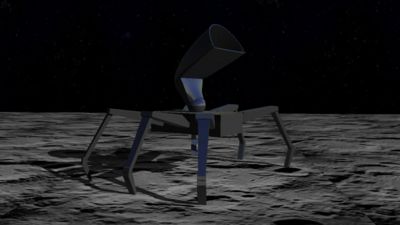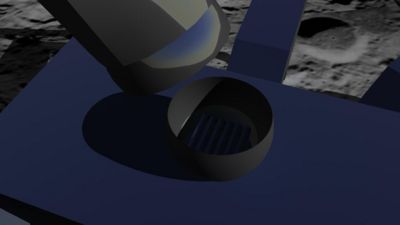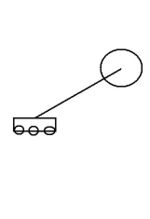Long Endurance Rovers
On most of Luna a roving robot explorer must either be made to endure 354 hour days followed by 354 hour nights or be considered a disposable rover. If we can not build things to continue operating a few years at a stretch on Luna, we might as well forget about a lunar base. This article suggests sample solutions to show that solutions exist. Better solutions than these will be developed.
Thermal Management
The Apollo astronauts used expendables for thermal management and recycled nothing. We can not use up expendables at that rate for years for robot explorers. Thermal management for lunar rovers is possible with radiators that do not use up expendables. One scheme is related to the simpler thermal management of a stationary base. At the equatorial region a wall could be set up running east and west and inclined away from the nearest pole by an angle equal to the latitude. The top of such a wall can be covered with reflective aluminum and that is the only part of the wall that the sun strikes. A trough shaped aluminum parabolic reflector can be built to shield the wall from the surrounding hot lunar landscape and reject incident sunlight to space. Such a trough would have a cross section in the shape of the curve that graphically represents y=x2 over the range of x=0.7, y=0.49 to x=-0.7, y=0.49 while the cross section of the wall would be represented by the line segment from x=0, y=0 to x=0 y=0.2. Sunlight that strikes the inside of such a trough will be focused above the wall and return to space. The wall can house a radiator shaped and coated for high emissivity. This radiator would be effectively shaded from sun and hot lunar terrain and radiate to the cold of space. By circulating a solution of water and ethylene glycol through this radiator cooling can be provided for sensitive equipment without throwing out any mass of evaporated liquid. Shrink this concept so that it can be carried by a rover and the rover should survive the day. The rover using such a radiator would best have six or more legs, so it could walk any direction without changing its heading.
Staying All Night
At night an insulative cover can be pulled over the radiator. Sintered brick shelters can be built for spending the night and pumped storage of high pressure oxygen can run electric generators at night. Until these things can be available a radio isotope thermal generator can provide heat and power during the night.
Micrometeoroid Protection
Micrometeoroids can be ignored until one strikes the radiator. The smallest of leaks would be extremely expensive even if the radiator were compartmentalized to allow one section to loose fluid while the rest of the radiator remains intact. The design should allow a leaking section to be isolated and pumped dry. The location of a leak would be sensed by the decrease of pressure in the leaking section. Beyond this the radiator can be removed from the micrometeoroid threat without too much reducing its effectiveness. Go back to the shape in cross section of the protective parabolic trough. Throw half the parabolic trough away and we are left with the cross section represented by y=x2 over the range from x=0, y=0 to x=0.7, y=0.49. Replace the left side of the parabolic trough with an aluminum foil box represented in cross section by the line segments x=0, y=0 to x=-0.2, y=0; x=-0.2, y=0 to x=-0.2, y=0.2; and x=-0.2, y=0.2 to x=0, y=0.2. Put the radiator in this box just to the right of the side represented by x=-0.2, y=0 to x=-0.2, y=0.2 and there is no strait line path from the radiator to the sky, but because of aluminum's reflectivity the heat radiated mostly reaches the black sky. Now make the aluminum foil trough and box double thickness with an inch of space between to make an effective micrometeoroid shield. So the radiator is shaded from the hot sun, shaded from the hot terrain and protected from micrometeoroids while still radiating reasonably well to cold space.
Alternate Radiator Shield for Rovers
The above design concept for a radiator shield is best suited for buildings. For a rover that would turn to all compass directions rather than traveling all various directions while maintaining a constant compass heading, there is an alternate radiator shield shape. A half paraboloid of revolution about the x=0, z=0 axis. The particular shape is y equals ((x2)+(z2)) in the range of z is positive and y ranges from 0 to 0.8. That curved surface would be formed of reflective aluminum foil along with the area of the z = 0 plane greater than y = x2 greater than y = 0.2 and less than y = 0.8. Heat would be radiated out through the area of the plane z = 0 where y is greater than x2 and less than 0.2. The heat would be reflected out along the positive y direction with the x=0, z=0 axis pointed at the sun. The radiator would have a circular shape on the top of the rover. An articulated section of the radiator shield would be composed of sections of spherical surfaces and a tube connecting the space enclosed by the sections of spherical surfaces to the paraboloid section of the shield. Pivots on opposite poles of the spherical sections would allow their turning about a horizontal axis while the pivots would be mounted on the radiator by a ring bearing allowing rotation about the vertical axis. The axis of the paraboloid should be able to point 360 degrees about to front, rear or side and vary in elevation from forty to ninety degrees from horizontal. When the sun is 40 degrees or more above the horizon, the axis of the paraboloid is pointed at the sun. When the sun is in the sky below 40 degrees of elevation the axis of the paraboloid points to the cold black sky along the azimuth opposite the sun. The radiator may need to be a larger fraction of the rover's surface area than indicated by the picture. Cameras, communication antennas, and manipulator arms are not shown but left to the reader's imagination.
Dust
There is no need for dust to be a bogeyman that prevents plans for long term operation of devices on Luna. The lunar dust is certainly nasty stuff, but it can be dealt with. Consider how dust gets stuck to devices on Luna. 1) DIRECT CONTACT: The area of devices that contact Luna must be limited to nonsensitive areas. The wheels of a rover can contact Luna and come into thermal equilibrium with the surface. The wheels would be locked to the axles and the rotary bearing would be within the rover allowing each axle to turn as one with its wheel. Dust picked up by the wheel would fall only on a protruding section of axle. 2) BALLISTIC TRANSFER: The speed of the rover would be limited to prevent dust being thrown in detrimental ballistic trajectories. 3) WIND: There are neither air currents nor wind on Luna. 4) ELECTROSTATIC FORCE: Static charges in dust particles cause the positively charged particles to move toward negative potentials and negatively charged particles to move toward positive potentials. Most of a rover would be covered with aluminum foil maintained at one potential. Antennae of the proper shape and charge can dissipate overall excess charge. Electronic grid elements of various shapes and potentials will either draw dust particles to disposal and so remove them from sensitive spots or simply repel dust particles from those spots. Simulated lunar dust in vacuum chambers on Earth can be treated in various ways to produce charged dust particles. So rover designs can be tested on Earth to be reasonably sure that dust will not settle in sensitive spots. What other way can dust move? It must obey physical laws.
Costs and Benefits
These design considerations certainly complicate the making of a lunar vehicle, but producing a device that will operate five or more years and potentially be repairable should be about 130 times as valuable as one that only works two weeks before turning into a piece of scrap. The least necessary of these design features are the micrometeoroid protective shields. The cost of these features includes the cost of a somewhat larger radiator. The cost must be balanced against the risk. Merely isolating damaged radiator sections may be most cost effective.
Another Alternate Radiator Shade
The solar cells for a rover could be stuck up on a pole and spread out to form an umbrella. The pole would be maneuvered to provide shade for the radiator. The bottom and sides of the rover would be insulated to protect from ambient high temperatures. The umbrella pole should be long enough that the infrared radiation from the bottom of the umbrella mostly misses the rover. The umbrella pole does not need to be so long if a second umbrella on the same pole is between the solar panel and the rover. The second umbrella would be the same diameter as the first, and from the shade of the first umbrella could radiate enough heat so that it would not be a significant source of radiant heat itself.
Predicting Possible Futures
There is an article entitled Show Stoppers that also deals with thermal management. As shown above, thermal management is not a show stopper. As can be shown point by point, there are no true show stoppers listed in the above mentioned article. The people of the United States have choices before them. We can cooperate with other nations in the economic development of Luna at a rate that really cannot be hurried in any reasonable way. We can abandon the development to other nations and a hundred years from now we will be buying communications and space based solar power from others. This is a long time frame for politicians to deal with. It is tempting to just deal with immediate problems and let them soak up the relatively small amount that can pay for developing lunar resources at a reasonable rate. Politicians in the United States must follow the people or be out of work. There is time to reach the people. Nothing will happen overnight on Luna.










